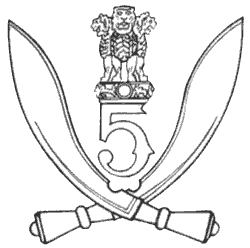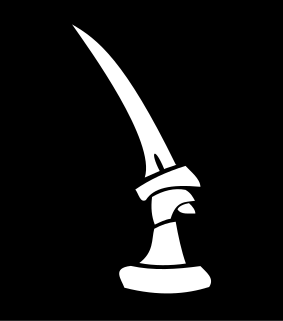
The 2nd King Edward VII's Own Gurkha Rifles was a rifle regiment of the British Indian Army before being transferred to the British Army on India's independence in 1947. It consisted of Gurkha soldiers from Nepal. The 4th Battalion joined the Indian Army as the 5th Battalion, 8th Gorkha Rifles, where it exists to this day. As part of the British Army, the regiment served in Malaya, Hong Kong and Brunei until 1994 when it was amalgamated with the other three British Army Gurkha regiments to form the Royal Gurkha Rifles. It is the only Gurkha regiment which did not have a khukuri on its cap badge.

5th Gorkha Rifles , also abbreviated as 5 GR(FF) is an infantry regiment of the Indian Army comprising Gurkha soldiers of Indian and Nepalese origin. It was formed in 1858 as part of the British Indian Army and served in the First World War and Second World War. The regiment was one of the Gurkha regiments that was transferred to the Indian Army following independence in 1947. The regiment was formerly known as the 5th Royal Gurkha Rifles . Since 1947, the regiment has served in a number of conflicts, including the Indo-Pakistani War of 1965 and the Indo-Pakistani War of 1971. It has also participated in peacekeeping operations in Sri Lanka.

The 5th Indian Infantry Division was an infantry division of the Indian Army during World War II that fought in several theatres of war and was nicknamed the "Ball of Fire". It was one of the few Allied divisions to fight three major enemy armies, Italian, German, and Japanese.

The Egyptian Expeditionary Force (EEF) was a British Empire military formation, formed on 10 March 1916 under the command of General Archibald Murray from the Mediterranean Expeditionary Force and the Force in Egypt (1914–15), at the beginning of the Sinai and Palestine Campaign of the First World War.

The 36th Indian Infantry Division was an infantry division of the Indian Army during World War II. The division was subsequently redesignated as a British Army formation, the 36th Infantry Division in September 1944. It served in India and during the Burma Campaign. After the end of the war it was disbanded and its remaining British units were transferred to the British 2nd Infantry Division.
The 23rd Infantry Brigade was an infantry brigade of the British Army that saw active service in both World War I, mainly on the Western Front, and World War II. In the Second World War the brigade saw active service in the Syria-Lebanon Campaign, the Western Desert Campaign and the Burma Campaign.

The 19th Indian Infantry Division was an infantry division of the Indian Army during World War II, and played a prominent part in the final part of the Burma Campaign.

The 17th Infantry Division is a formation of the Indian Army. During World War II, it had the distinction of being continually in combat during the three-year-long Burma Campaign.

The 20th Indian Infantry Division was an infantry division of the Indian Army during World War II, formed in India, and took part in the Burma Campaign during World War II. In the immediate aftermath of the War, the bulk of the division was deployed to French Indochina to oversee the handover from Japanese to French rule.

The 23rd Indian Infantry Division was an infantry division of the Indian Army during World War II. It fought in the Burma Campaign. It was then reformed as a division of the independent Indian Army in 1959.
The 44th Indian Airborne Division was an airborne forces division of the Indian Army during World War II, created in 1944. It provided a parachute battalion for one minor airborne operation, but the war ended before the complete formation could take part..
Iraqforce was a British and Commonwealth formation that came together in the Kingdom of Iraq. The formation fought in the Middle East during World War II.

The 25th Indian Infantry Division was an infantry division of the Indian Army during World War II which fought in the Burma Campaign. It was re-raised within the post-independence Indian Army in 1948.
The Order of Battle, East African Campaign shows the ground forces available to both sides in East Africa on the date that the Italians declared war on Britain and France, 10 June 1940. An update is also provided for the British and Commonwealth forces involved in the 1941 offensive.
The 7th (Meerut) Division was an infantry division of the British Indian Army that saw active service during World War I.
The 3rd (Lahore) Division was an infantry division of the British Indian Army, first organised in 1852. It saw service during World War I as part of the Indian Corps in France before being moved to the Middle East where it fought against troops of the Ottoman Empire.
This is the order of battle for the Syria-Lebanon Campaign, a World War II campaign between the Western Allies and Vichy France during June and July, 1941.
The Burma Corps ('Burcorps') was an Army Corps of the Indian Army during World War II. It was formed in Prome, Burma, on 19 March 1942, took part in the retreat through Burma, and was disbanded on arrival in India in May 1942.
The organisation of Divisions and Brigades of British Army in 1939, at the outbreak of the Second World War, is listed below.
The Order of battle, Keren 1941 shows Italian army forces that participated in the Battle of Keren from February to March 1941 and British troops in Sudan on 20 January 1941, which participated in military operations against Eritrea during the East African Campaign 1940–1941.














